Oregon Journal of Orthopaedics | Volume XI, 2022
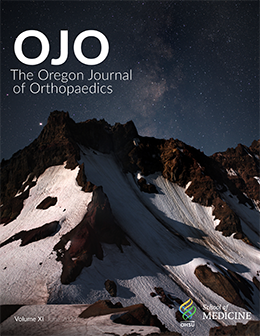
Featured articles from this issue:
- New Faculty Spotlight: Kimberly Hall. M.D.
- New Faculty Spotlight: Stephen Wallace, M.D.
- New Faculty Spotlight: Tracy Townsend, M.D.
- Enough: Looking Back on Thirty Years with Ronald Turker, M.D.
- Update on diversity, equity, and inclusion (DEI) initiatives
- A Reflection on Three Years as Hayhurst Professor
- Iron in the Fire
- Impact of PROFHER on Trends in Proximal Humerus Fracture Treatment in the United States
- Gigli Saw Olecranon Osteotomy for Distal Humerus Fractures: A Cadaveric Study
- Application of DA (Damage Assessment) software to preoperative MRI for prediction of surface area of tissue applied during osteochondral allograft reconstruction in the knee
- Oncology Patients Are High Cost Outliers in Total Joint Replacement Bundled Payment Systems
- Acetabular Risk Calculator (ARC): A Perioperative Risk Stratification Tool to Predicting Major Postoperative Complications in Acetabular ORIF
- Alumni Updates: Courtney Bell, M.D.
- Alumni Updates: Shanjean Lee, M.D.
- Alumni Updates: Elizabeth Lieberman, M.D.
- Alumni Updates: Peters Otlans, M.D.
- Alumni Updates: Travis Philipp, M.D.
New Faculty Spotlight: A Q&A session with Kimberly Hall, M.D.
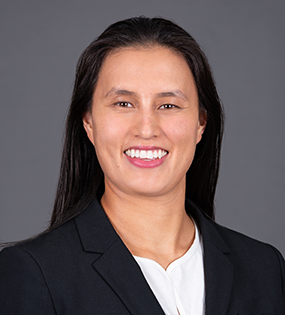
By Danielle Peterson, M.D.
Hometown: Kaneohe, HI;
Medical School: John A. Burns School of Medicine, University of Hawaii, Honolulu, HI
Residency: Orthopedic Surgery, Stanford Hospital and Clinics, Stanford, CA
Fellowship: Orthopedic Surgery Sports Medicine, University of Michigan, Ann Arbor, MI
Favorite Restaurant in Portland: Brick and mortar restaurant – Eem. All comers – Kau Kau PDX
Go-to OR music? If I’m choosing, it’s usually “The Green Radio” Playlist on Spotify. Otherwise, whatever Anesthesia is playing
Tell us a little about yourself.
I was born and raised in Hawaii and still very much consider Hawaii to be my home, even though I haven’t lived there since medical school. I enjoy water activities primarily swimming, playing water polo, outrigger canoe paddling, and surfing. It’s been a bit difficult to do those here so hiking, snowboarding, and biking have filled that hole nicely so far. My husband and I have enjoyed exploring Oregon since we moved here, whether that’s going to the coast or to the mountains or even just checking out new restaurants, breweries, and wineries.
What brought you to Hillsboro Medical Center?
This job was a great opportunity that matched my interest in being in a smaller practice at a more community-based level while also having the opportunity to work with students and residents in a educational setting.
What made you choose Sports Medicine as a specialty?
There are many things I love about Orthopedics but I have always appreciated the focus on improving quality of life. I love that the sports medicine subspecialty works to improve the quality of life of people at any age and with any activity level.
Favorite thing about Portland/PNW so far?
So far, I have loved the accessibility of activities here – whether we want to go biking or snowboarding or check out the coast, all of these options are readily available to us within a couple hours’ drive.
What are some goals you have for your practice?
I hope to build a practice that provides consistent, reliable, great care to the patients of Hillsboro and beyond.
What is the biggest difference between practicing in Oregon and where you were trained?
The biggest difference so far has been the weather – the rains a lot more here than it did in northern California, and it was definitely a lot colder in the Midwest.
Do you have any research interests or projects you’re looking forward to pursuing?
I currently have an interest in improving and increasing the literature available regarding water polo athletes and their injuries. We’ll see where that takes me.
What is something that you learned during your training that you wish you knew earlier in residency?
I definitely wish took more notes during residency. I didn’t really start documenting the details of all of my cases until I was a senior resident, and it’s amazing how many cases that you wish you remembered or little pieces of advice that you wish you wrote down. Would have been nice to have notes from those cases for the first few years of residency.
Any advice for graduating chiefs?
As you move from residency to fellowship and into early practice, I have three pieces of advice: 1) Have confidence in your training and your level of knowledge, 2) Don’t settle for “this is how I was taught” – try to understand why your mentors are doing what they are doing so that you can do the same, and 3) Never be afraid to ask for help.
New Faculty Spotlight: A Q&A session with Stephen Wallace, M.D.
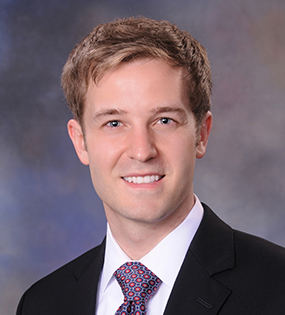
By Danielle Peterson, M.D.
Hometown: Paducah, KY
Medical School: Baylor College of Medicine; Houston, TX
Residency: Loyola University Medical Center; Maywood, IL
Fellowship: Orthopaedic Trauma – Harborview Medical Center; Seattle, WA
Limb Lengthening and Complex Reconstruction – Hospital for Special Surgery; New York, NY
Favorite Restaurant in Portland:
Finding new foodie favorites every week.
Go-to OR music?
The room picks the mix most often. But if I had it my way: Classic Rock Mondays, Country Tuesdays, Wildcard Wednesdays, Salsa Thursdays...
Tell us a little about yourself.
I was born in small town Kentucky. I have five siblings including an adopted twin. I worked as an engineer for a global health company before attending medical school. I’ve been in a recent running kick.
What brought you to Summit Orthopaedics/Emanuel?
Summit Orthopaedics offers a perfect mix of trauma and complex reconstruction in the private practice setting in conjunction with valuable resident education and teaching opportunities.
What made you choose to become dual fellowship trained in Trauma and Deformity?
Inspired by both my patients and mentors during residency, I chose dual Trauma and Deformity fellowships. I am captivated with specific orthopaedic solutions to complex extremity problems. My deformity training gives me additional perspectives and complementary tools to tackle issues like limb malalignment, bone defect management, and amputation / reconstruction surgery.
Favorite thing about Portland/PNW so far?
Trails, mountains, water, snow, trees, bridges, summer, fall, winter, spring.
What are some goals you have for your practice?
My goals are to advance orthopaedic service through uncompromised patient care, impactful research, technological progress, and widespread education.
Do you have any research interests or projects you’re looking forward to pursuing?
I am focused on pushing the limits for limb salvage, advanced reconstruction, and amputation surgery through projects like three-dimensional surgical planning, automatic hexapod struts, and osseointegration.
What is something that you learned during your training that you wish you knew earlier in residency?
Find what drives you and fiercely pursue.
Any advice for graduating chiefs?
Remember why you started. Stay patient centered. Thank your mentors. Pay it forward.
New Faculty Spotlight: A Q&A session with Tracy Townsend, M.D.
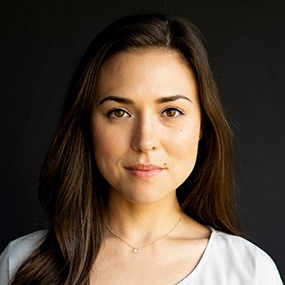
By Danielle Peterson, M.D.
Hometown: I grew up overseas in Korea and Japan, then Florida and Washington, DC, so I don’t really have a hometown!
Medical School: University of Virginia School of Medicine, Charlottesville, VA
Residency: Harbor-UCLA Medical Center, Torrance, CA
Fellowship: Boston Children’s Hospital, Boston, MA
Favorite Restaurant in Portland: Top Burmese
Favorite activity outside of the hospital: Exploring Forest Park
Go-to OR music?
The Organica playlist on Spotify
Tell us a little about yourself.
I’m of mixed East Asian and European descent, and thus very interested in the intersection of Eastern and Western medicine practices. I’m married to the Love of my life Michael Townsend, and we have one son Leonardo “Leo”. Outside of orthopaedic surgery, I’m really interested in the integration of psychedelic plant medicines into western allopathic health systems, and believe they will play a big role in all areas of medicine, including physician development.
What brought you to Kaiser?
I was interested in a general pediatric orthopaedic practice, and at Kaiser, I get to deliver orthopaedic care to everyone 16 and under. I love that it is not fee for service and that I am in the same network with all of the primary care providers who refer their patients to me with the same electronic health record which facilitates better care coordination and delivery. I also have fantastic mentors with whom I am able to be co-surgeons, which allows for a real meeting of the minds for difficult cases. This is also a very progressive organization, as far as health care goes, and physicians here really try to prioritize work life balance.
What made you choose Pediatric Orthopaedics as a specialty?
I can’t think of a greater honor or privilege than taking care of the medical needs of children. It is also a wonderfully diverse field. I get to treat everything from femur fractures to ACL ruptures to scoliosis, and I manage to have a lot of fun along the way, thanks to some of my hilarious patients.
Favorite thing about Portland/PNW so far?
The nature, the open minded people, the emphasis on localism.
What are some goals you have for your practice?
We are currently working to develop a comprehensive model for virtual fracture care, something that a lot of busy parents really appreciate. I also hope to create a suite of complementary and holistic care that addresses the mental, emotional, and spiritual dimensions of the musculoskeletal system.
What is the biggest difference between practicing in Oregon and where you were trained?
The biggest difference is I get to follow up with all of my patients and there is much better continuity of care.
Do you have a personal interest in a specific aspect of pediatric orthopaedic surgery, and why?
I have an interest in preventative musculoskeletal care and believe that healthy habits implemented during childhood have benefits that compound over a lifetime.
What is something that you learned during your training that you wish you knew earlier in residency?
I wish that I had more compassion for myself as a humble learner and also understood that orthopaedic surgery is a constantly evolving field, and thus there is no one right way to do anything. All throughout training, it felt like there was this expectation that I should already know the “right” answer, and so I didn’t ask enough questions. I was too busy trying to impress my attendings, when really I should have been asking why more.
Any advice for graduating chiefs?
My advice is to really invest in your relationships, whether that’s relationships with your attendings during fellowship or in your personal life with your family and loved ones. There is something to glean from every interaction that you have, and if you keep an open mind, you never know who you will cross paths with and what opportunities will come your way. Take notes on all of your patients and save all operative reports, imaging, and postop protocols. Cultivate a Beginner’s Mind and always be learning, no matter how small the detail. Take time for self care - you can’t take care of others well if you aren’t taking care of yourself.
Enough: Looking Back on Thirty Years with Ronald Turker, M.D.
By Ronald Turker M.D.
Was thirty years of practice enough? Enough for me to retire? Irrelevant.
The question is whether it was enough time to pay off my debt. Not the Jacobian debt owed to a Laban-like healthcare system, at times capricious and cruel, but the debt of trust. Trust bestowed by my patients, my colleagues, and my students.
My story begins in 1981, I was happily attending an upstate New York college and studying to become a paramedic. And that was the plan. I’d graduate and head back to New York City to work. A single phone call from my father changed all that. He asked me how the ambulance gig was going.
I told him, “Great. Loving it!” He also asked about my patients. “What happens to them after you leave the hospital? Do you ever hear?”
My response was “Well, sometimes the E.D. nurses or docs give me updates. But you don’t really know what happens afterwards.” He pressed. Then he followed with a simple question. “Aren’t you curious?”
And that was it, the dislodged pebble that started a career. Of course, I was curious. Of course, I cared.
After getting into med school, my first step was to find a mentor. Ritchie Cantor, head of the Peds E.D., was smart, funny, and compassionate: he could also cut through bullshit like a kosher butcher on a Friday afternoon. Our job, he said, is to support our patients through the journey, even though we know where every train’s heading.
Below are four pearls I’ve gathered through my career.
Pearl number one: Pick your mentors like you would a spouse. They truly affect your life.
Orthopedics and Me
I am an accidental orthopedist. In med school, I set my sights on becoming a pediatric general surgeon. But in 1987, I did not match into a single general surgery program in the country.
Pearl number two: It never pays to piss off the department chairman.
Thanks to Dr. Patricia Numann, the student program director, I landed a general surgery “prelim” spot in a trial-by-fire Southside Chicago hospital. A hospital that no longer exists. A year later, as funding for my position dried up, I was shown mercy by the Orthopedic Chairman, who hired me to fill an unexpected vacancy.
Pearl number three: It’s always better to be lucky than good.
I am indebted to all these good people who shepherded me along the way and to those who kept me afloat. None of us has gotten to this position of trust and respect without the help of countless others, including our patients, our support team at work, and our families at home.
My aim to do the right thing every day was my Sisyphean attempt to satisfy that debt. At times exhausted and irritated, but mostly exhilarated, I appreciated all that medicine brought me.
Pearl number four: Learn to love the rock.
I don’t believe in altruism—we get what we give. It’s the version of karma where you lay your head on the pillow and know you did your best. Then get up the next day, and do it again. Never perfectly, but always with good intent.
Were thirty years enough? Am I square with my debt?
My head says no, but my body says it will have to do.
Update on diversity, equity, and inclusion (DEI) initiatives
By Kate Hutchison, M.D. and Bopha Chrea, M.D.
The last year has provided many opportunities for new and old initiatives alike in the orthopaedics and rehabilitation department. Orthopaedic surgery remains the least gender-diverse medical subspecialty with approximately 15% of residency positions filled by women. Additionally, the racial and ethnic diversity within orthopaedics has in fact decreased within the last 20 years. As medicine becomes more aware of issues of diversity and inclusion both within the ranks of physicians as well as within the interactions with patients, we will continue with efforts to bring a focus to these issues within our own community.
While COVID-19 precautions have limited the ability of visiting professors to present grand rounds in person, it has also allowed for multiple grand rounds speakers to virtually visit the program to speak on issues of structural inequalities. Dr. Jaysson Brooks of Texas Scottish Rite Hospital for Children joined us to speak on neuromuscular scoliosis and then met with the residents for a deeply engaging session on structural racism. Dr. Selina Poon of Shriner’s Hospital for Children in Southern California, a leading expert in research on diversity and inclusion within orthopaedic surgery, also joined us for Grand Rounds to highlight her research on trends in gender, racial, and ethnic diversity within orthopaedics as well as the impact on USMLE exam performance. Finally, Grand Rounds will also be given by Dr. Nancy Yen Shipley, one of the co-founders of Speak Up Ortho, an initiative to address bias, inequities, and harassment within orthopaedic surgery. She and fellow Speak Up Ortho panelists will discuss their work and research as part of this important initiative with the department.
Thanks to a grant obtained by Dr. Chrea, in April 2022 a resident journal club focused on DEI topics allowed for discussion of equity and inclusion within the program and within orthopaedics as a subspecialty. Articles discussed included several by Dr. Poon. This is a journal club focus we hope to continue moving forward into the future. An additional new program for 2022 is a DEI subinternship scholarship for visiting medical students rotating with OHSU orthopaedic surgery. Scholarship funds are available to students who are underrepresented in medicine (URM), with the hope that a lower financial burden for away rotations allows for more equity within the already complex and costly residency application process.
Finally, we are excited to have been able to resume community outreach partnerships outside of OHSU. Dr. Friess, Dr. Chrea, and Amy Sothern PAC spent a morning at the Jefferson High School career fair as part of the Ontrack OHSU partnership to highlight orthopaedics as a career choice with an interactive demonstration for 9th grader students. The Wy’east Partnership has also been active this year, with portions of musculoskeletal education taught by orthopaedic surgeons including clinical workshops with physical exam skills and casting and splinting workshops. We look forward to more opportunities to interact with the community outside of OHSU in the year to come.
A Reflection on Three Years as Hayhurst Professor
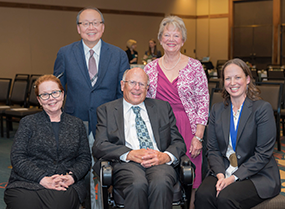
By Danielle Peterson, M.D. and Jacqueline Brady, M.D.
As Dr. Jacqueline Brady completes her three-year term as the Hayhurst Professor, she reflects on work accomplished during this time:
The Hayhurst Fund, in support of Orthopaedic Innovation and Research, has been an incredible asset to scholarly work in the OHSU Department of Orthopaedics & Rehabilitation. First and foremost, it funded a research assistant, John Ghattas, who has been productive on several fronts. He has kept us up to speed as a member of the active and ongoing JUPITER multicenter research project focusing on patellar instability. Initial publications from that ongoing research effort have focused on imaging reliability and epidemiology, and we expect to be able to add valuable information to guide treatment of patients with patellar instability as we complete the longer-term follow-up of each patient. With John’s assistance navigating the paperwork and communications, OHSU is becoming a member of the STaR Trial, a Department of Defense funded multicenter effort focusing on treatment of patients with multiligamentous knee injuries. Finally, John has spent countless hours helping to gather data in the arthroscopy lab as the residents on the sports rotation (and those participating in our once annual Arthroscopy Boot Camp) practice surgical techniques in the shoulder, knee, and hip. We are in the process of analyzing motion pattern data to determine whether we can detect short-term improvement in arthroscopic skills on an objective basis, and hope to be presenting and publishing soon.
In the arthroscopy lab, the Hayhurst Fund has been a twofold help from an equipment standpoint: first, in upgrading our motion pattern sensors to the more technologically advanced set that no longer requires an hours-long processing step; and second, in updating the surgical tools that we use in the lab to match those that the residents see in the operating room. We now have a fully functional arthroscopy lab experience on three different platforms: the dry FAST tools and models for practice of fundamental skills, the wetlab experience with donor materials, and a virtual reality simulator to allow repetition and modification of the surgical landscape (for example, create a particular pattern of a labral tear in the shoulder and a meniscus tear in the knee) as the residents improve their skills.
The final role of the Hayhurst Fund in its first iteration was the support of a project designed to better understand the “work” of orthopaedic surgery. The Whoop device is a validated tool for measurement of sleep and recovery. The Hayhurst Fund was used to purchase enough devices, straps, and battery packs to outfit all interested residents and faculty. Preliminary findings include the finding that home call for residents and faculty significantly decreases sleep quantity and quality, and baseline physiologic parameters take multiple days to return to baseline. The study is ongoing, thanks to our participants. We hope that this project will be helpful in particular for making decisions about optimal safety and wellness when creating call schedules and planning patient handoffs, based on what we learn about resident and faculty sleep and recovery.
A new faculty beneficiary of this very generous support will be chosen in the coming months, with a goal to pass the mantle as the new academic year begins. The Hayhurst legacy will therefore be multiplied. We are incredibly thankful to have this support, and aim to make our specialty better for it!
Iron in the Fire
By Laura Sokil, M.D.
Inspired by an idea: Built on personal experience, Dr. Zachary Working, Director of Orthopaedic Trauma at OHSU, and Dr. Danielle Peterson, OHSU PGY-3, set out to develop an investigator initiated, randomized controlled drug trial investigating the use of intravenous iron therapy (IVIT) for anemia after orthopaedic fracture care. With this idea of developing a high-quality trial with level 1 evidence came the need for considerable funding. They were recently awarded three grants to fund various aspects of the study, including the Medical Research Foundation Early Clinical Investigator Grant (Peterson), Collins Medical Trust Grant (Working), and Orthopaedic Trauma Association Resident Research Grant (Peterson).
Premise for the trial: Acute blood loss in orthopaedic trauma and operative fracture care contributes substantially to perioperative anemia, which places patients at increased risk for complications including surgical site infection, cardiovascular complications, and even death. Anemia has further clinical implications in quality of life measures and is associated with fatigue, impaired physical performance, decreased exercise capacity, and mood disturbances. Thus, evaluation and treatment of perioperative anemia is critical in risk mitigation within orthopaedic surgery. The current standard of care for anemia is transfusion of packed red blood cells only in cases of severe anemia due to the substantial associated risks of transfusion. A safer alternative is desirable because a critical number of patients do not meet the restrictive transfusion threshold and may suffer negative effects from anemia during recovery from the acute insult. The focus of this project is to pilot investigation of the benefits of IVIT in traumatically injured patients. Working and Peterson aim to assess the effect of IVIT on resolution of anemia, patient-reported fatigue, physical function and depression, and immune cell function. Peterson states, “we expect this study to provide a better understanding of IVIT, which has the potential to alter our treatment approach of anemia in patients who sustain traumatic orthopaedic injury, thereby leading to decreased risks and improved recovery.”
Advancing the field: The study has expanded beyond the Orthopaedic Department, with critical partnerships in the Department of Hematology and Division of Trauma. Dr. Joseph Shatzel, Assistant Professor of Biomedical Engineering and fellowship trained in Hematology & Medical Oncology, has been a crucial clinical advisor in anemia and the use of IVIT in their patient population. Dr. Joseph Aslan, Assistant Professor of Biomedical Engineering, and his lab are contributing necessary basic laboratory resources to better understand the biologic consequences of anemia in the traumatic setting and the role iron repletion plays on platelet function. Dr. Nick Willett, Associate Professor in Bioengineering at the University of Oregon Knight Campus, will be collaborating with the team to further characterize immune cell response after trauma. Dr. Martin Schrieber, Professor of Surgery, has graciously offered to be an advisor to the project as he is extensively experienced in clinical research, funding acquisition, and large-scale trials.
Reflecting on her work over the past several months, Dr. Peterson states that, “Success so far has been marked by hard work and many failures - hundreds of hours of prep work, rejected grant applications, unanticipated road blocks. We have learned so much in getting this study off the ground and with each failure came the opportunity to grow. We knew we had a great idea, but without the bumps in the road, we would never have had such an incredible team or study plan. We are excited by the possibilities this study has to expand and positively impact the care of our trauma patients. I personally am truly thankful to have the unwavering support of Dr. Working and the Orthopaedic Department to go after my research dreams during residency!”
Senior Projects
Impact of PROFHER on Trends in Proximal Humerus Fracture Treatment in the United States
Sam Cheesman, M.D./M.B.A., Qian Yang, M.P.H., Jung Yoo, M.D., Omar Nazir, M.D., Adam Mirarchi, M.D.
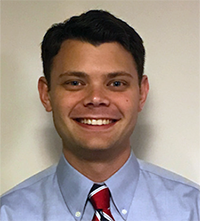
Sam Cheesman, M.D./M.B.A.
Hometown: Muncie, IN
Medical School: Indiana University, Indianapolis, IN
Fellowship Plans: Hand Fellowship at University of New Mexico
INTRODUCTION
PROximal Fracture of the Humerus Evaluation by Randomization (PROFHER) is a high-quality randomized controlled trial (RCT) published in 2015 that compares outcomes for operative and nonoperative treatment of proximal humerus fractures (PHFs). The study found no difference in Oxford Shoulder Scores between operative and nonoperative groups at 2 and 5 years. The aim of this study was to assess whether the high-quality data produced by the PROFHER trial was implemented by American orthopaedic surgeons, namely, to examine whether operative treatment decreased following its publication in 2015.
METHODS
Using the PearlDiver database, patients with PHFs were identified with ICD-9 and ICD-10 codes from 2011-2019. The year 2015 was established as the point at which change would be expected in practice patterns. CPT codes were used to identify patients who underwent operative treatment including open reduction internal fixation (ORIF), total shoulder arthroplasty (TSA) and hemiarthroplasty. Patients not undergoing these treatments were presumed to be treated nonoperatively. Statistical analysis was performed using simple linear regression as well as piecewise linear regression to assess both change over time as well as change in slope starting in 2015.
RESULTS
Simple linear regression analysis showed increase in total operative treatment (0.18% per year, p = 0.01) as a result of increased rate of ORIF (0.06% per year, p=0.04) and TSA (0.27% per year, p<0.001); there was a decrease in rate of hemiarthroplasty treatment (-0.15% per year, p<0.001). Despite these changes, piecewise linear regression showed no significant change in slope (change in rate of treatment per year) in 2015 for total operative treatment, ORIF or TSA.
CONCLUSIONS
This study illustrates that the PROFHER study did not significantly impact rates of operative treatment in the United States. This warrants additional investigation into the implementation of research findings in the field of orthopaedic surgery.
Gigli Saw Olecranon Osteotomy for Distal Humerus Fractures: A Cadaveric Study
Ryan W Hadden, M.D.; Austin R Thompson, B.S.; Omar F Nazir, M.D.; Zachary M Working, M.D.; Adam J Mirarchi, M.D.
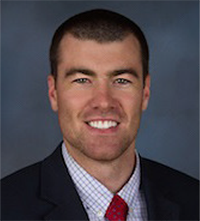
Ryan Hadden, M.D.
Hometown: Salem, OR
Medical School: University of Alabama, Birmingham, AL
Fellowship Plans: Hand and Upper Extremity, Brown Department of Orthopaedic Surgery
PURPOSE
A novel plate-on Gigli saw osteotomy technique has been developed to simplify olecranon osteotomy management. The goal of this study was to evaluate the difference in procedural time, osteotomy surface area, and surgeon self-reported confidence in performing the standard chevron osteotomy and novel plate-on Gigli saw technique.
METHODS
Four board certified orthopaedic surgeons and ten residents each performed chevron and Gigli saw olecranon osteotomy techniques on cadaveric specimens. All osteotomies were stabilized with an olecranon plate and screws. Time to complete the procedure and time to complete each osteotomy were separately collected for each technique. Osteotomies were analyzed for quality of reduction using three separate reduction parameters. Digital images of the osteotomized surface areas were captured and analyzed via ImageJ Software. Pre and post simulation surveys were completed addressing participant experience. A Likert scale was used to discern self-reported confidence.
RESULTS
The chevron technique required more total time on average than the Gigli saw technique, however, the difference was deemed equivalent. Time to complete the olecranon osteotomy was greater on average with the chevron technique than Gigli saw technique, however, the difference was only trivial. The surface area resulting from the chevron technique was larger on average than the surface area from the Gigli saw technique; this was a trivial difference. While half of the reductions with the chevron technique were of poor reduction quality, only one reduction with the Gigli saw technique was of poor reduction quality. Nonetheless, the proportion of participants that achieved poor reduction quality with the chevron technique but not the Gigli saw was found to be equivalent to the proportion of participants that achieved poor reduction quality with the Gigli saw technique but not the chevron technique. Self-reported confidence was significantly greater with the Gigli saw technique than with the chevron technique.
CONCLUSIONS
The two techniques demonstrated equivalence in total time and reduction quality, and only a trivial difference in surface areas. However, the Gigli saw technique demonstrated a better pattern of reduction, and greater participant confidence than the chevron technique.
CLINICAL RELEVANCE
The plate-on Gigli saw osteotomy technique is a simple alternative to the standard chevron osteotomy that yields a more predictable reduction pattern and is easy to perform.
Application of DA software to preoperative MRI for prediction of surface area of tissue applied during osteochondral allograft
Samuel G Moulton, M.D.; Matthew Provencher, M.D.; Armando Vidal, M.D.; Jack Wiedrick, M.S., M.A.; Kaytee Arnold, B.S.; Dennis Crawford M.D., Ph.D.
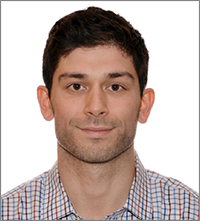
Samuel Moulton, M.D.
Hometown: Eugene, OR
Medical School: OHSU, Portland, OR
Fellowship Plans: UCSF Sports Medicine & Shoulder Fellowship
BACKGROUND
Preoperative imaging is routinely used to estimate the quantity of tissue provided for fresh osteochondral allograft in the knee. Use of three-dimensional (3D) modeling software for this purpose may improve defect assessment to allow a more accurate estimate of osteochondral allograft tissue required for reconstruction and eliminate the potential circumstance of acquiring an inadequate quantity of tissue for transplant surgery.
PURPOSE
The purpose of this study was to evaluate the capacity of the Damage Assessment (DA) 3D MRI modeling software for predicting the osteochondral allograft surface area used in surgery.
METHODS
Patients who underwent fresh osteochondral allograft (FOCA) surgery to the distal femur with preoperative MRI imaging were included. The DA reports included total surface area of the lesion and the surface area of each subarea of injury (Red: full-thickness cartilage injury ICRS Grade IV; Pink: partial-thickness cartilage injury ICRS Grade 2-3; Purple: bone cyst; Blue: bone marrow edema; Green: bone loss). Probability of overestimation of graft tissue area by DA was estimated using a Bayes-moderated proportion, and the relationship between the prediction discrepancy (i.e. over- or underestimation) and the magnitude of the DA estimate was assessed using nonparametric local-linear regression.
RESULTS
A total of 36 FOCA surgeries and corresponding DA reports were analyzed. The DA total surface area measure overestimated the area of FOCA tissue transplanted an estimated 81.6% of the time (95% CI [67.2, 91.4]), corresponding to a median overestimation of 3.14 cm2, or 1.78x the area of FOCA actually transplanted. The DA software overestimated the area of FOCA transplanted 100% of the time for defect areas measured >4.21 cm2. For defects <4.21 cm2, the maximum-magnitude underestimation of tissue area was 1.45 cm2, or on the fold scale 0.63x the transplanted area; this is approximately 2/3 of what is required, so a plausible heuristic is that multiplying a small (i.e. <4.21) DA-measured area of injury by a factor of ~1.5 would yield an overestimation of the tissue area transplanted most of the time.
CONCLUSION
The DA 3D modeling software overestimated osteochondral defect size >80% of the time in 36 distal femoral FOCA cases. A policy of consistent but limited overestimation of osteochondral defect size may provide a more reliable basis for predicting the minimum safe amount of allograft tissue to acquire for transplantation.
Oncology Patients Are High Cost Outliers in Total Joint Replacement Bundled Payment Systems.
Erik Woelber, M.D.; Kenneth R. Gundle, M.D.; Jonah Geddes, M.P.H.; Kathryn L. Schabel, M.D.; James B. Hayden, M.D., Ph.D.; Saifullah R. Hasan, B.S.; Lauren M. Raymond, B.S.; Yee-Cheen Doung, M.D.
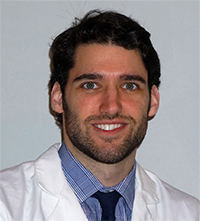
Erik Woelber, M.D.
Hometown: Anchorage, AK
Medical School: University of Washington, Seattle, WA
Fellowship Plans: Adult Reconstruction, Rothman Orthopaedics
BACKGROUND
In 2016, the Centers for Medicare and Medicaid Services began its first mandatory bundled payment program, the Comprehensive Care for Joint Replacement (CJR) model, which covers a 90-day episode of care. This study determined whether oncology patients enrolled in the CJR bundle incur higher hospital costs than patients with osteoarthritis (OA).
METHODS
A retrospective review of all patients enrolled in the CJR bundled payments system from April 1, 2016 to June 31, 2018 at a single academic medical center was conducted. To determine whether tumor patients had higher total episode costs, this group was compared to patients diagnosed with OA using a 2-tailed t-test. To adjust for moderators of total hospital costs, we used generalized linear regression with a log-link, including multiple variables abstracted from chart review.
RESULTS
Three hundred fourteen patients met inclusion criteria (12 primary or metastatic tumors, 302 OA). Fifty-eight percent of tumor patients were over the target price vs 16% of OA patients. The mean tumor patient had $40,862 for total internal hospital costs compared to $16,356 in the OA group (P < .001). Length of stay was greater in the tumor group (6.75 vs 2.0 days, P < .001). A greater percentage of tumor patients were discharged to a skilled nursing facility (67% vs 27%, P = .006) with significantly higher skilled nursing facility episode costs ($18,852 vs $7731, P = .04). With adjustment for fracture status, tumor patients were 5.36 times more likely to exceed the CJR target price than OA patients (risk ratio 5.36, confidence interval 3.44-8.35, P < .001) and 50 times more likely to be outliers over the regional threshold than OA patients (risk ratio 50.33, confidence interval 16.33-155.19, P < .001).
CONCLUSION
Oncology patients enrolled in the CJR bundled payment model incur significantly higher costs and have higher cost variability than patients with OA. We recommend that oncology patients be excluded from the CJR bundle.
Acetabular Risk Calculator (ARC): A Periop Risk Stratification Tool to Predict Major Postop Complications in Acetabular ORIF
Natalie L Zusman, M.D.; Megan Rushkin, M.P.H.; Natasha S McKibben; David M Gallacher; Darin M Friess, M.D., M.P.H., FAAOS; Zachary M Working, M.D.
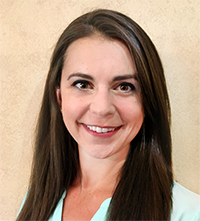
Natalie Zusman, M.D.
Hometown: Portland, OR
Medical School: OHSU, Portland, OR
Fellowship Plans: Pediatric Orthopaedics, at Children’s Hospital Los Angeles
OBJECTIVES
The purpose of this study was to create a data-driven risk stratification tool to predict postoperative complications following acetabular open reduction internal fixation.
DESIGN
Retrospective cohort study
SETTING
Level 1 academic trauma facility
PATIENTS/PARTICIPANTS
371 adult patients received unilateral traumatic acetabular open reduction internal fixation between 2008-2018
INTERVENTION
Open or percutaneous reduction and internal fixation
MAIN OUTCOME MEASUREMENTS
Major medical (such as pneumonia, septic shock, death) and surgical (conversion to arthroplasty, deep infection, loss of reduction) complications occurring within 30 and 365 days postoperative, respectively.
RESULTS
24% of the 371 included patients experienced at least one major complication. Of the potential variables analyzed, variables predictive of complication were (in order of most to least predictive): ISS > 35, operative time > 2.7hr, age > 53yrs, trauma system entry, intraoperative blood loss > 1L, female sex, preoperative hemoglobin < 10.2 (g/dL), BMI > 28.5 kg/m2, associated fracture patterns, ASA≥3, and after-hours surgery (>50% of OR time after 15:00). Model performance: discrimination (ROC AUC=0.77), calibration (Hosmer-Lemeshow P=0.72).
CONCLUSIONS
We present a sophisticated risk stratification tool (Acetabular Risk Calculator, “ARC”) predictive of major complications after acetabular ORIF using 8 pre and 3 perioperative variables (after-hours surgery, operative time and blood loss). Surgeons may utilize the ARC during decision making with the aim to anticipate and mitigate complications.
Alumni Updates
Courtney Bell, M.D.

After graduating residency in 2019, I moved to the east coast to complete my adult reconstruction fellowship at the Rothman Institute. I had an amazing opportunity to build upon my skills and knowledge from OHSU in total joint replacement and bonus trauma call. I couldn’t ask for better mentors and friends from OHSU and fellowship. After fellowship, my husband and I moved to Naples, Florida which has been a great place to live and where I am currently in private practice doing primary and revision hip and knee replacement as well as taking care of many, many hip fractures in Southwest Florida.
Shanjean Lee, M.D.
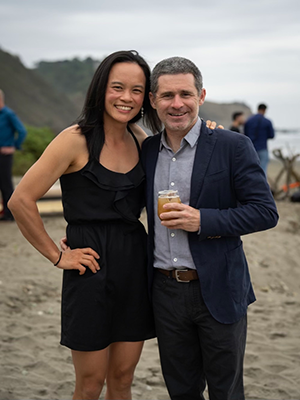
After graduating from residency in 2019, I started practice as a general orthopedic surgeon at the VA hospital in Reno. My partner Mikey and I chose Reno, NV as our new home partly because of the strong orthopedic program at the Reno VA and partly because of Reno’s proximity to the Sierra Nevada mountains, as we both love to rock climb.
Since starting practice at the Reno VA, I have built a truly general practice - my week in the OR might include a reverse total shoulder, a MPFL reconstruction, a total knee, a rotator cuff repair, and some carpal tunnel releases or a hip fracture to round things out. Because of this, I am so grateful for the well-rounded program at OHSU and for the mentors there who continue to guide me when I have questions about tough cases. Also since starting in Reno, I have had the opportunity to spend more time in Yosemite and completed one of my lifetime goals - free climbing El Capitan! All in all, life after residency has been very fulfilling in multiple arenas: full of new challenges and learning opportunities that have helped me keep growing as a person and as an orthopedic surgeon.
Elizabeth Lieberman, M.D.
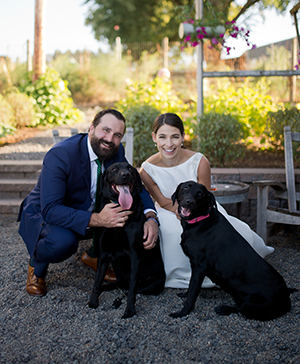
After graduating from residency in 2019 I moved to St. Louis for a fellowship in Adult Reconstruction and Hip Preservation at Washington University in St. Louis. The first part of my fellowship was spent learning complex arthroplasty and hip preservation procedures and exploring St. Louis (highly recommend going to a Cardinals baseball game and trying Gooey Butter Cake if you go!). The COVID pandemic hit during the second half of my fellowship, which shook things up a bit but allowed for some time to do research and more trauma/ urgent arthroplasty procedures.
After fellowship, I returned to Portland and got married in a very small ceremony, which was completely different from the wedding my husband Steve and I started planning in 2019 but ended up being pretty amazing. I have been in practice at Adventist Health Portland for the past two years and have enjoyed working in a small community hospital doing mostly arthroplasty procedures and fracture care. I will be joining the Orthopaedic + Fracture Specialist group this summer and am excited to work with OHSU residents.
Last year I started the OHSU Orthopaedic Alumni Association and look forward to being able to plan in-person events soon. I also joined the board of the Oregon Association of Orthopaedic Surgeons and was able to participate in the Orthopaedic Advocacy Week, which I highly recommend to anyone who is interested in getting involved. Outside of work I spend my time throwing a ball for my two black labs, Seamus and Wrigley, chasing PRs on my Peloton, and working on my new hobby- golf, which is incredibly humbling.
Peters Otlans, M.D.
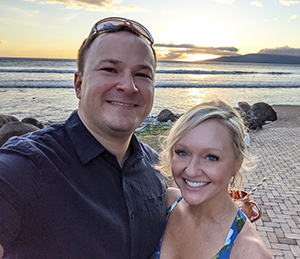
After five memorable years in Portland, I moved to Philadelphia to complete a sports medicine fellowship at Thomas Jefferson University, through the Rothman Orthopaedic Institute. While the COVID pandemic struck during my time there, I had experiences that will last me a lifetime. While there, I helped take care of each of the city’s major professional sports franchises, two college teams, and high schools, gaining invaluable experience with their team physicians, medical staff, and athletes. In addition, Rothman challenged me clinically and academically with an ambitious program created to get us extensive operating room and research experience. It was truly eye-opening and I am so grateful to all of my (many) mentors there!
Making the trip with me to Philadelphia was Maria, who I met in Portland. She has been an incredible support to me throughout this entire journey. We were married last June and are expecting a baby girl later this summer. We have settled back in the Pacific Northwest and I have joined a private practice in Burien, called Proliance Southwest Seattle Orthopedics. There are some OHSU connections here, as one partner, Dr. Brian Jones, is a previous OHSU spine fellow, and another, Dr. Alan Barronian, is father to recent OHSU ortho residency graduate Trevor. They have welcomed me with open arms to our relatively small practice of five surgeons. I am working with the local school district as a team doctor and doing a variety of cases here, including simple and complex arthroscopy, arthroplasty, and community trauma.
OHSU trained me well, and I feel well-equipped to handle pretty much any case I encounter. If I have doubts or questions I reach out to mentors, partners, and old friends, especially my residency cohort who are the best! A heartfelt hello and thank you to all my former Portland mentors, friends, and coresidents. I miss you all!
Travis Philipp, M.D.
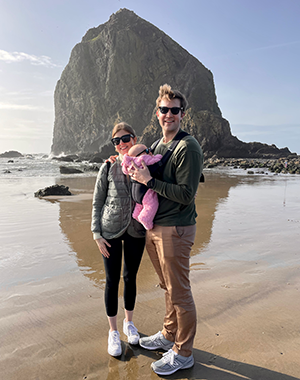
After graduating in 2019 I moved to the East Village/Gramercy area of Manhattan for my spine fellowship at NYU. I worked with wonderful faculty and had great co-fellows. It was certainly an interesting year to be in NYC with COVID hitting just past the halfway point of my fellowship. We knew the situation was bad when all of the orthopaedic surgeons were distributed throughout the hospital working in different roles. I found myself working on a medicine team for a couple of weeks during the peak, which was certainly an experience I was not expecting. I will always be grateful for all of the people that pulled together and worked through that difficult time. It was a humbling experience.
The silver-lining was that with everything shut-down, my wife who had been splitting time between NYC and Portland was now just in NYC. After fellowship we made our way back to Portland and I was very fortunate to start practice at OHSU. The learning curve the first couple years of practice is far and away the steepest that I’ve experienced throughout my training as a surgeon. I’ve been fortunate to have wonderful partners to bounce things off of and help me continue to grow as a surgeon. I have also been working with the school of medicine as an academic advisor for the medical students which has been a rewarding experience in addition to my clinical duties.
Most exciting since graduating residency though has been the arrival of our beautiful and energetic (she still doesn’t seem to sleep) daughter, Campbell. She was born on Thanksgiving in 2021 and has been keeping us on our toes ever since.